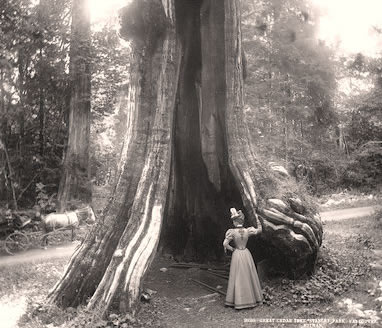
| Galleries — Index |
The "Big Hollow Tree"
|
 |
 |
Left: "Big Tree, Stanley Park, Vancouver BC." Old postcard. This postcard is an instance of failed appropriation.
The iconic Big Hollow Tree is pictured surrounded by the symbols of
imperial glory. |
 |
"Great Cedar Tree, Stanley Park," 1897. |
 |
Left: Hollow Tree, Stanley Park, 2007. In January 2009 Vancover's Park Board backed down from its hasty and contested decision to fell the "snag" and instead approved the Stanley Park Hollow Tree Conservation Society's engineering plan and fund raising strategy to conserve the Hollow Tree as a monument (right). The Society argued that the Hollow Tree is iconic, "a wonderful local reminder of the majesty of our original forests." Millions of dollars were raised for conservation from private individuals, corporations and the provincial and federal governments.
|
| |